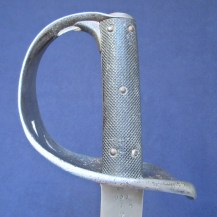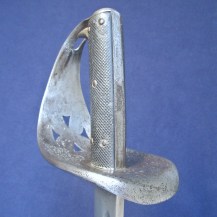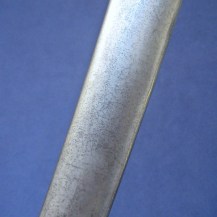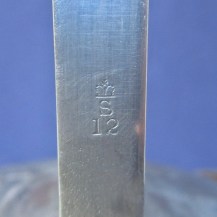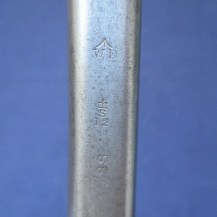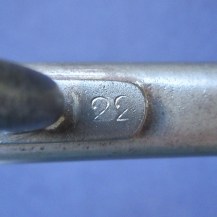British 1885 Pattern Cavalry Trooper's Sword, Worcestershire Yeomanry
Curved, single fullered blade, ambidextrous basket hilt with pierced Maltese Cross symbol and turned-over edges, black pressed leather grips secured by five steel rivets. Overall length 1.02m (40 inches) blade length 88cm (34½ inches). Wood-lined steel scabbard with two fixed mounting rings near the throat.
The blade is stamped on one side with the maker’s mark ‘Weyersberg Kirschbaum & Co Solingen’ and issue dates ‘5/88’ and ‘6/89’, and on the other side with ‘Y C’ indicating issue to a unit of Yeomanry Cavalry, a broad arrow and ‘WD’, indicating War Department property, two crown inspection marks with ‘S’ for Solingen, a crown inspection mark with ‘BR’ indicating that the sword underwent repair at Birmingham, and a mark of eight lines radiating from a circle, the meaning of which is unknown – I have seen it on other Solingen import blades of the period so it may be a factory mark. The spine of the blade is stamped with the same Solingen inspection mark. The outside of the hilt is stamped with another broad arrow War Department mark. The inside of the hilt is stamped with another issue date ‘8/89’, ‘WR YC’, indicating the Worcestershire Yeomanry Cavalry, and ‘22’, a rack number.
The flat base of the mounting ring on the scabbard’s trailing edge is also stamped with ‘WR YC’ and ‘22’. Above this mounting ring the throat piece of the scabbard is stamped with another broad arrow War Department mark, and the date ‘/88’. Below the mounting ring the spine of the scabbard is stamped with a further broad arrow War Department mark, a Solingen inspection mark identical to those on the blade and the date ‘/88’ again. Based on the commonality of markings the blade and scabbard must be an original pair.
British domestic manufacturers in the late 1800s could not always meet government production contracts for swords and bayonets, and the excess was typically outsourced to the large German factories based in the city of Solingen, of which Weyersberg, Kirschbaum and Co was one of the most prominent. British government inspectors on site ensured quality was maintained.
The Worcestershire Yeomanry Cavalry was formed in 1794 as part of a nationwide raising of volunteer units to counter the threat of French invasion. It was disbanded in 1827 but a noted rise in civil unrest in the county led to it being reformed in 1831 - yeomanry could be called upon to support the civil powers in case of riot or unrest and were often an effective deterrent. In 1837 it became The Queen's Own Regiment of Worcestershire Yeomanry Cavalry.
Edwin ‘Balaclava Ned’ Hughes, the last survivor of the Charge of the Light Brigade, was sergeant-instructor to the regiment from 1873 to 1886. In 1887 the regiment was awarded the title of the Queen's Own Worcestershire Hussars (although it remained yeomanry). In 1899 the Imperial Yeomanry was formed to allow yeomanry cavalry to serve in the Boer War and the QOWH provided 129 volunteers, which formed the 6th Squadron, 5th Regiment Imperial Yeomanry under Colonel Meyrick, of which 16 were killed and 20 wounded.
During WW1 volunteers of the QOWH formed part of the 1st Midland Brigade, which arrived in Alexandria, Egypt in April 1915 where they assisted in unloading the dead and wounded arriving from Gallipoli. In August they themselves were dispatched to Gallipoli where they fought as infantry until the evacuation in January 1916. They thereafter returned to Egypt and were assigned to patrol the Qatia (or Katia) area east of the Suez Canal, monitoring for Ottoman incursion and protecting the railway and water supply. The Ottomans, under the German commander von Kressenstein, attacked in force in April 1916, overwhelming the outnumbered 5th Brigade at the Battle of Katia. The Worcestershire contingent took particularly heavy losses with more than 300 killed or captured, only one officer remaining to lead the retreat. The 5th Brigade went on to mount the Charge at Huj, the last British charge against guns in history. The cavalry, consisting of men from the Worcester Yeomanry and Warwickshire Yeomanry, attacking with swords drawn, successfully overran and captured the Ottoman artillery and machine guns.
The regiment became field artillery in 1922, then an anti-tank regiment in 1938. It remained in that role during WW2, notably forming a rearguard at Cassel to destroy vehicles advancing towards the evacuating forces at Dunkirk. As 53rd (Worcestershire Yeomanry) Air Landing Light Regiment, RA, part of the 6th Airborne Division, it was deployed from gliders near Caen in June 1944 – the first British field battery ever to be deployed by air. During the Battle of the Bulge the regiment claimed to have been the first in the war to land their shells on German soil. They were airdropped again behind German lines in 1945 as part of Operation Varsity. Immediately after the war the regiment was deployed to policing duties in Palestine. It was reconstituted in 1947 as the 300th (Worcestershire Yeomanry) Anti-Tank Regiment, then converted to an armoured regiment in 1950, returning to its old cavalry name of the Queen's Own Worcestershire Hussars.
It was amalgamated with the Warwickshire Yeomanry in 1956 to form the Queen's Own Warwickshire and Worcestershire Yeomanry. In 1967 the regiment was reduced in size and reconstituted as infantry. In 1969 it was effectively disbanded - reduced to a cadre of five members. Around 100 former members were invited to form a signals squadron – designated 67 (Queen's Own Warwickshire and Worcestershire Yeomanry) Support Squadron - within the 37 (Wessex and Welsh) Signal Regiment. This unit still exists today under the same name, but was renumbered 54 in 2009.
In 1971 the five-man cadre was expanded again to a squadron and amalgamated with the Staffordshire Yeomanry and Shropshire Yeomanry, each forming one of the three squadrons of the new Queen's Own Mercian Yeomanry, a reconnaissance regiment. In 1992 this was amalgamated with The Duke of Lancaster's Yeomanry to form The Royal Mercian and Lancastrian Yeomanry, with A Squadron carrying the lineage of the Staffordshire, Warwickshire and Worcestershire Yeomanry. The RMLY was disbanded in 2014, with A Squadron transferring to the Royal Yeomanry.
This leaves the Worcestershire Yeomanry with two modern successors: B (Warwickshire and Worcestershire Yeomanry) Squadron, Royal Yeomanry and 54 (Queen's Own Warwickshire and Worcestershire Yeomanry) Support Squadron, 37th Signal Regiment.
The blade is bright with some peppered pitting towards the tip. Some pitting to the hilt. The pressed leather grips are in good condition with little handling wear to the chequering,. The original leather washer has been lost. The scabbard has some patination and areas of light pitting, and three small dents to its lower section.








